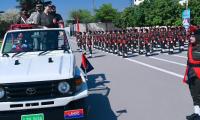Capital suggestion
Backgrounder: December 6, 2015: Nasser Jaffer, chairman PIA, announced at a press conference that “Pakistan International Airlines Corporation has been converted into a company (paving the way for its privatisation).” December 8, 2015: Mohammad Zubair, chairman Privatisation Commission, told Agence France-Presse (AFP), “Government will privatize Pakistan International Airlines by next July.” December 14, 2015: The Joint Action Committee (JAC) of PIA announced a three-hour daily strike.
January 11, 2016: Ishaq Dar, minister for finance, categorically said that the “government had no intention to privatize PIA.” February 2, 2016: PM warns protesting PIA employees will be fired. Three protesting PIA employees are killed. PIA flight operations suspended across Pakistan. February 9, 2016: PIA union workers call off strike after eight days of protests.
Successful privatisation rests on three pillars: transparency, a social safety net for the employees and an effective communication strategy. PIA’s privatisation is in a mess because it lacks transparency. PIA’s privatisation is in a mess because the Privatisation Commission failed to provide a social safety net to PIA’s workers. PIA’s privatisation is in a mess because the Privatisation Commission has no communication strategy – neither with the employees nor with the general public.
PIA spends around 14 percent of its revenues on its employees. Airlines around the world spend between 15 percent to 20 percent on their employees. PIA spends around 50 percent of its revenues on fuel. Airlines around the world spend about the same (an unprecedented 70 percent drop in oil prices means windfall profits for airlines).
The one thing that distinguishes PIA from the rest is that PIA’s top management has absolutely no experience of running a national airline. Imagine: the advisor to the PM on aviation is the PM’s friend. Imagine: the chairman is the friend of the PM’s friend. And the board of directors is filled with close friends, bosom friends, confidantes, alter egos and soul mates.
I’ll be there for you/ So no one told you life was gonna be this way/ Your job’s a joke, PIA is broke/ When the rain starts to pour/ I’ll be there for you/ Like I’ve been there before/ ‘Cause you’re there for me too
What is the real disease that’s killing PIA? Is it excessive political interference, or are there serious issues with PIA’s organisational ethos? What is the real disease? Is it the commercial viability of PIA as an operating entity? Is PIA a commercial entity or a social welfare organisation?
In 2014, PIA spent Rs48 billion on fuel. This year the fuel bill will drop by 70 percent or down to Rs15 billion, saving PIA a wholesome Rs33 billion. All that PIA needs is political will followed by a classic triple-R turnaround strategy – Repositioning, Retrenchment and Reorganisation.
PIA’s repositioning would mean ‘replacement of leadership and other senior managerial staff, changes in planning systems and turning around the human resource management system’. Retrenchment would mean ‘selling non-core assets, deleting unprofitable product lines, quitting difficult markets, out-sourcing, cutting costs and raising efficiency’.
All that PIA needs to do is to ‘shift towards market orientation and customer focus’. The easiest thing to demand is new aircraft. What’s really needed is not new aircraft but Repositioning, Retrenchment and Reorganisation.
The writer is a columnist based in Islamabad.
Email: farrukh15@hotmail.com Twitter: @saleemfarrukh
A representational image showing residents walking at a wholesale market in Karachi. — AFP/FileOnce again there is...
A representational image showing late Pakistani human rights activist and Supreme Court lawyer Asma Jahangir. —...
A representational image showing a security personnel sanding guard beside a ship carrying containers at Gwadar port....
A health worker administers polio vaccine drops to a child during a door-to-door polio vaccination campaign in Lahore,...
Armed militants of the banned Tehreek-e-Taliban Pakistan pose for a photograph in Orakzai Agency. —...
An aeroplane of the national flag carrier of Pakistan is seen in this file photo. — AFPWhile Pakistan considers...







